While many assume bathroom plants won’t survive due to low light and humidity, you’ll find that several species actually thrive in these conditions. Your bathroom’s unique environment can become the perfect setting for a curated collection of greenery that adds both style and function. From air-purifying varieties that combat moisture to low-maintenance options that require minimal care, these 10 trending plant choices will transform your bathroom into a refreshing sanctuary.
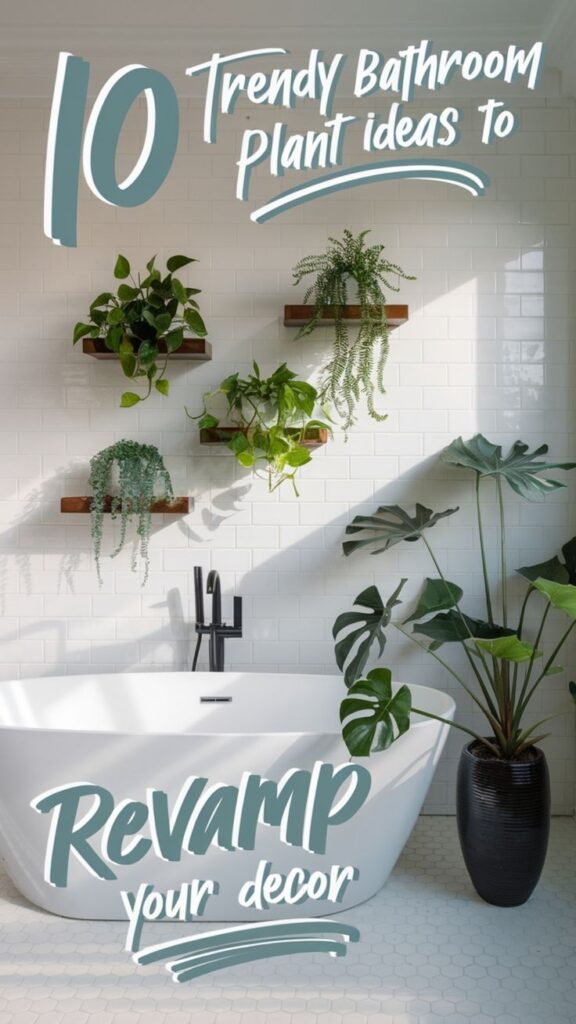
Contents
- 1 Lush Hanging Pothos for Natural Shower Curtains
- 2 Snake Plants: The Perfect Corner Statement
- 3 Compact Air Plants for Small Spaces
- 4 Window Shelf Succulents and Cacti Collections
- 5 Bamboo Arrangements for Zen Vibes
- 6 Orchids: Adding Elegant Sophistication
- 7 Aloe Vera: Beauty and Functionality
- 8 Floating Shelves With Cascading Ferns
- 9 Tropical Peace Lilies for Humidity Lovers
- 10 Wall-Mounted Vertical Garden Solutions
Lush Hanging Pothos for Natural Shower Curtains
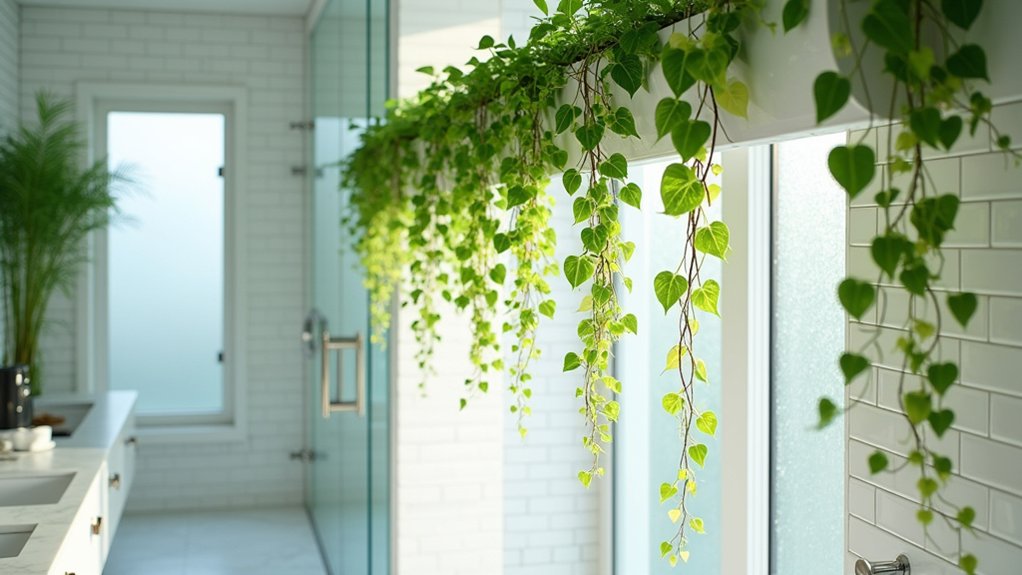
Pothos plants cascading from hanging baskets or wall-mounted holders create a stunning natural curtain effect in bathrooms, with their heart-shaped leaves trailing elegantly downward.
These versatile vines come in various varieties, including golden, marble queen, and neon, offering different patterns and colors that can extend several feet in length. When strategically placed near shower areas, they create a spa-like atmosphere while helping to filter air and increase humidity.
Growing Conditions:
- Bright to moderate indirect light, avoiding direct sunlight
- High humidity levels (50-70%), making bathrooms ideal environments
- Well-draining potting mix with added perlite or orchid bark
- Temperature range of 60-80°F (15-27°C)
- Water when top 1-2 inches of soil feels dry
- Fertilize monthly during growing season with balanced liquid fertilizer
Regular pruning is essential to maintain the desired curtain shape and prevent the vines from becoming too lengthy or sparse.
Wipe leaves monthly with a damp cloth to remove bathroom moisture buildup and dust, which helps maintain photosynthesis and prevent pest issues.
Rotate the plant periodically to ensure even growth, and trim any yellowing or damaged leaves promptly to maintain its lush appearance and prevent disease spread.
Snake Plants: The Perfect Corner Statement
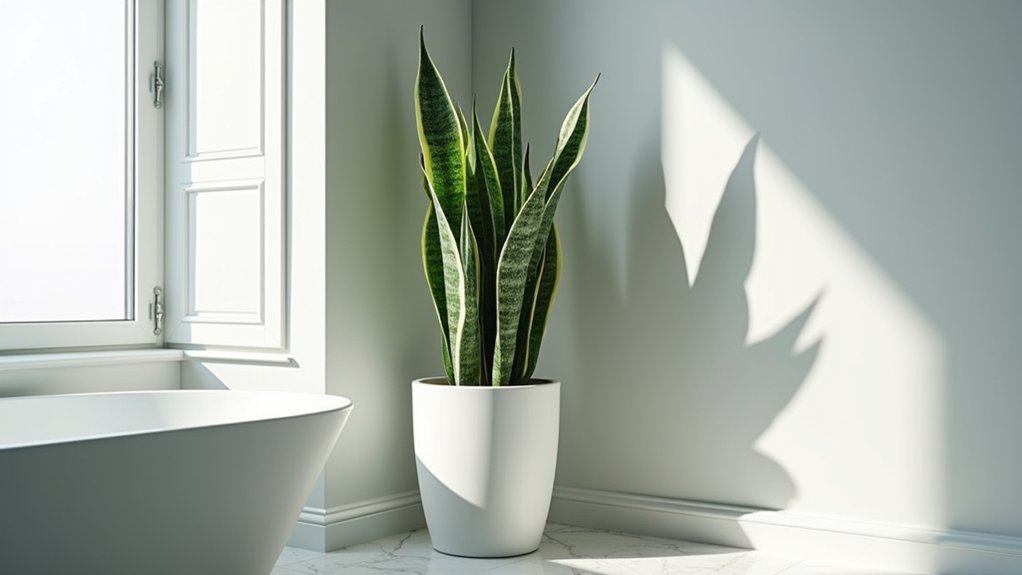
Snake Plants (Sansevieria) make striking corner statements with their tall, rigid, sword-like leaves that grow upright in elegant clusters.
These architectural plants feature dramatic variegated patterns of green, yellow, or white stripes, with some varieties reaching heights of 3-4 feet. Their bold vertical growth pattern and structural form create a modern, sculptural element that perfectly fills empty bathroom corners while purifying the air.
- Light: Tolerates low to bright indirect light; avoid direct sunlight
- Water: Allow soil to dry completely between waterings; water every 2-4 weeks
- Soil: Well-draining potting mix; prefers slightly sandy soil
- Humidity: Adapts to any humidity level
- Temperature: Thrives in 60-85°F (15-29°C)
- Container: Use pot with drainage holes to prevent root rot
- Fertilizer: Light feeding with balanced fertilizer every 2-3 months during growing season
Regular dusting of leaves with a damp cloth maintains the plant’s glossy appearance and helps it photosynthesize efficiently.
Remove any yellowed or damaged leaves at the base, and check occasionally for signs of root rot, especially in humid bathroom conditions.
When repotting is needed (every 2-3 years), divide large plants into smaller sections to control size and propagate new plants, always ensuring the pot size is appropriate for the root system.
Compact Air Plants for Small Spaces

Air plants (Tillandsia) are compact, soil-free plants that make perfect additions to small bathroom spaces. These unique epiphytes grow naturally by attaching to other plants or surfaces rather than requiring soil, making them incredibly versatile for displaying in creative ways. Their slender, spiky leaves form elegant rosettes that can range from silvery-gray to bright green, with some varieties producing vibrant blooms when mature.
- Light: Bright, indirect light; avoid direct sunlight which can burn leaves
- Humidity: Thrives in humid environments, making bathrooms ideal
- Temperature: Prefers 50-90°F (10-32°C)
- Water: Weekly misting or soaking for 20-30 minutes
- Mounting: Can be placed on any surface that allows air circulation
- Ventilation: Requires good air flow to prevent rot
- Support: Can be mounted on driftwood, shells, or displayed in glass containers
To maintain air plants, shake off excess water after misting or soaking to prevent rot, and ensure they dry completely within 4 hours. Rotate plants periodically to ensure even growth and exposure to light.
Remove any dead or browning leaves by gently pulling them away from the base, and fertilize monthly during growing season with a bromeliad-specific fertilizer at quarter strength. If displaying in glass containers, remove plants periodically to allow complete drying and prevent moisture buildup.
Window Shelf Succulents and Cacti Collections
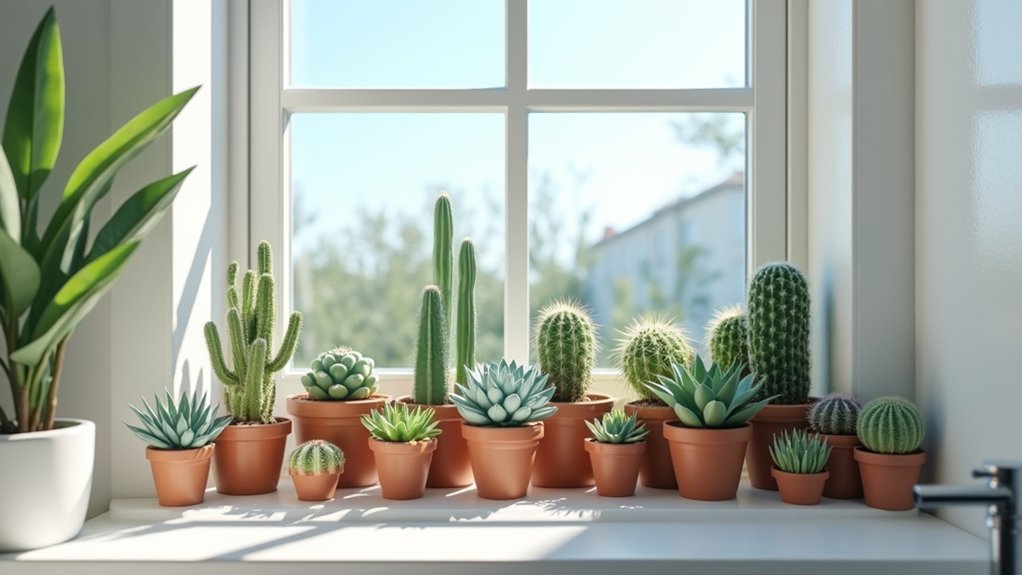
Window shelf collections of succulents and cacti create an eye-catching display in bathroom spaces, featuring diverse shapes, sizes, and textures that add natural beauty while requiring minimal space.
These hardy plants can include rosette-forming echeverias, towering snake plants, compact haworthias, and various desert cacti, arranged on window shelves to maximize light exposure while adding architectural interest to the bathroom environment.
- Light: Bright, direct sunlight for 4-6 hours daily; south or west-facing windows ideal
- Water: Sparse watering every 2-3 weeks; allow soil to dry completely between waterings
- Soil: Well-draining cactus mix with added perlite or coarse sand
- Temperature: 60-80°F (15-27°C)
- Humidity: Low to moderate; tolerant of bathroom humidity
- Container: Pots with drainage holes; shallow containers for succulents, deeper for cacti
- Spacing: 2-3 inches between plants to allow for growth and air circulation
Regular maintenance involves removing dead leaves, rotating plants quarterly for even growth, and inspecting for signs of overwatering or pest issues.
During winter months, reduce watering frequency by half and ensure plants aren’t touching cold window panes.
Fertilize sparingly during the growing season with a balanced, water-soluble fertilizer at quarter strength, and repot every 2-3 years or when plants outgrow their containers.
Bamboo Arrangements for Zen Vibes
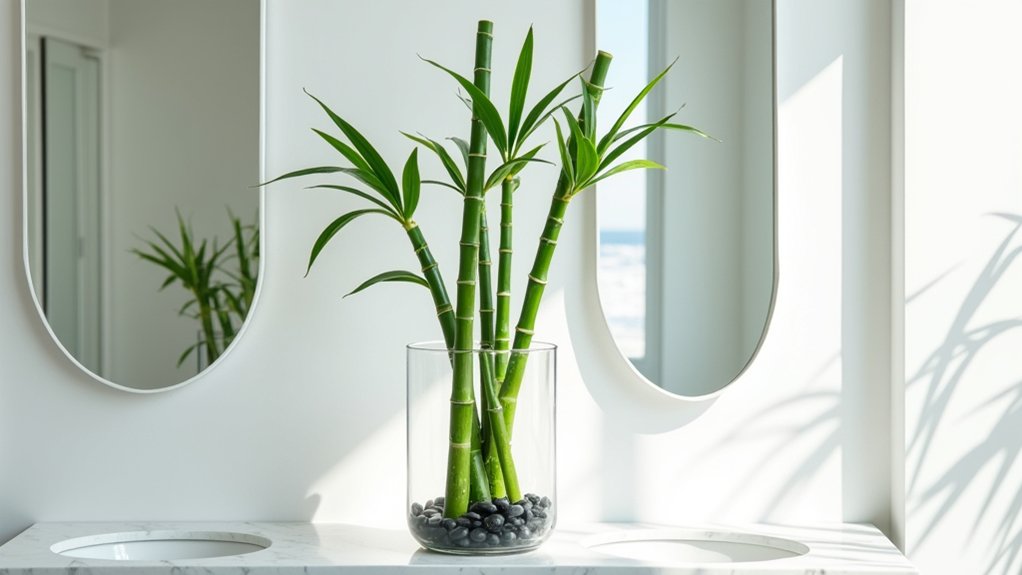
Bamboo arrangements create a serene, spa-like atmosphere in bathrooms, offering vertical interest and natural elegance. Lucky bamboo (Dracaena sanderiana) can be artfully arranged in clear vases with decorative stones, while larger bamboo varieties can be positioned in floor planters for dramatic effect.
These arrangements often incorporate multiple stalks of varying heights, arranged in symbolic numbers according to feng shui principles, with fresh green stems and delicate leaves that add a distinct Asian aesthetic to the space.
- Light Requirements: Bright indirect light; can tolerate low light conditions
- Water Needs: Clean, filtered water; keep water level covering roots
- Growing Medium: Pebbles or well-draining potting soil
- Temperature: 65-95°F (18-35°C)
- Humidity: High humidity preferred
- Container: Clear vases for water-grown specimens or well-draining pots for soil-grown plants
Regular maintenance of bamboo arrangements involves changing the water every 7-10 days for water-grown specimens, trimming yellowed leaves promptly, and rotating containers periodically to ensure even growth.
Remove any algae buildup on stones or containers with a gentle cleaning solution, and maintain cleanliness around the base of the plants. For soil-grown bamboo, prune any shoots that become too tall or begin to yellow, and dust leaves regularly to maintain their lustrous appearance and ensure proper photosynthesis.
Orchids: Adding Elegant Sophistication
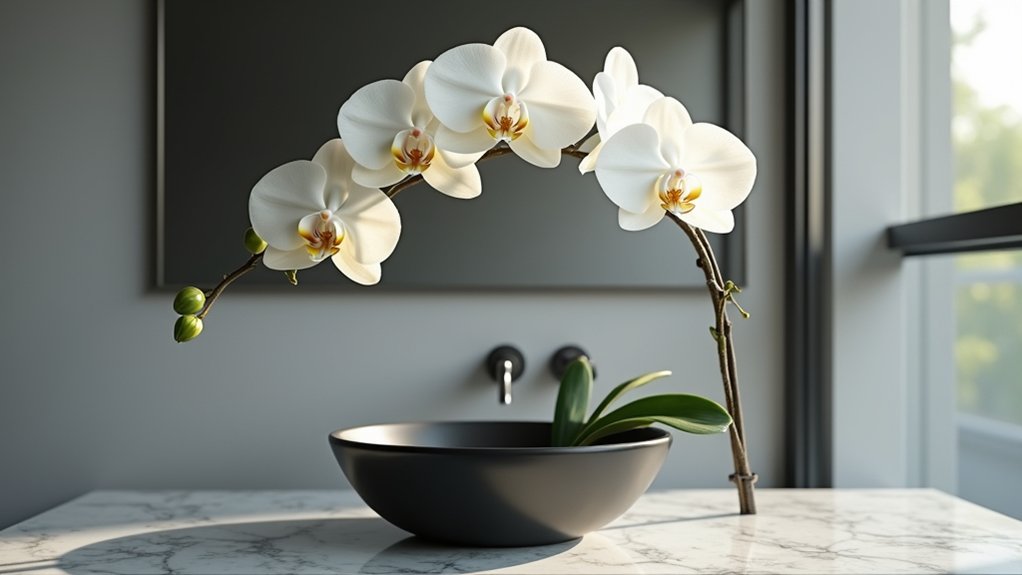
Orchids bring a touch of exotic luxury to bathroom spaces with their graceful stems and striking blooms that can last for months. Their delicate petals and architectural form create an air of sophistication, while their diverse varieties offer options ranging from classic white Phalaenopsis to vibrant purple Dendrobiums.
These tropical beauties naturally thrive in humid environments, making them perfectly suited for bathroom settings.
- Light: Bright, indirect light; avoid direct sunlight which can burn leaves
- Humidity: 50-70% humidity level
- Temperature: 65-80°F (18-27°C)
- Water: Once weekly, allowing soil to dry slightly between waterings
- Growing Medium: Specialized orchid mix with excellent drainage
- Container: Clear plastic or clay pots with drainage holes
- Air Flow: Moderate circulation to prevent fungal issues
Regular maintenance of orchids centers on proper pruning and post-bloom care. Once flowers fade, trim the spike just above a node to encourage reblooming, or cut it completely if it turns brown.
Remove any yellowed or damaged leaves, and dust the leaves monthly to maintain their ability to photosynthesize effectively. Repot every 1-2 years when the growing medium breaks down, and feed with a balanced orchid fertilizer at quarter strength during the growing season for optimal health.
Aloe Vera: Beauty and Functionality
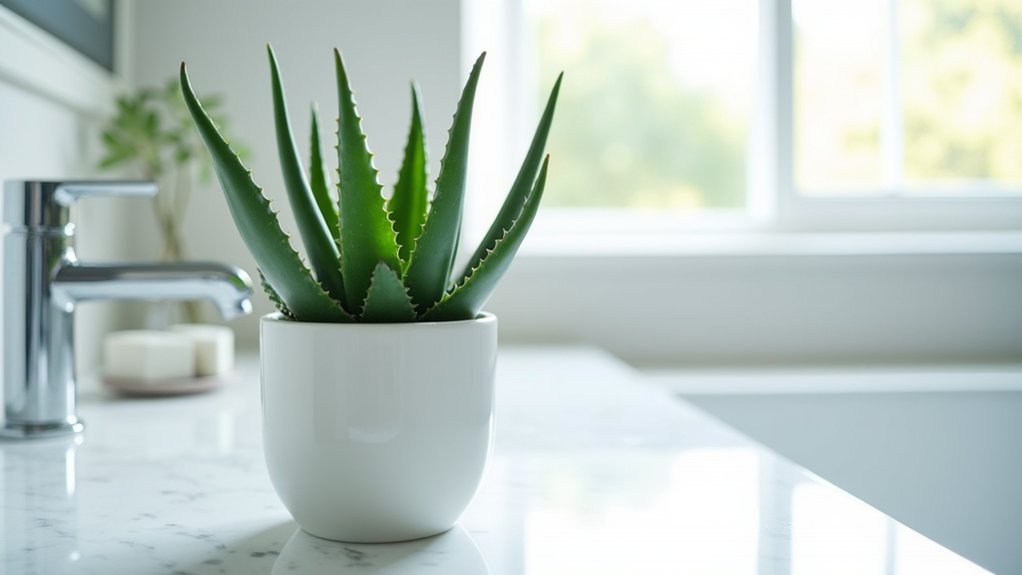
Aloe vera is a striking succulent that combines aesthetic appeal with practical benefits in bathroom spaces. Its thick, fleshy leaves grow in a rosette pattern, featuring serrated edges and a distinctive blue-green color that adds a modern touch to bathroom decor.
Beyond its architectural beauty, aloe vera produces a clear gel inside its leaves that’s renowned for its healing properties, making it a functional choice for minor burns, cuts, and skin irritations.
- Light: Bright, indirect sunlight; can tolerate some direct morning sun
- Water: Allow soil to dry completely between waterings; reduce watering in winter
- Soil: Well-draining cactus or succulent mix
- Temperature: 55-80°F (13-27°C)
- Humidity: Tolerates bathroom humidity well but doesn’t require it
- Container: Pot with drainage holes to prevent root rot
Regular maintenance of aloe vera focuses primarily on preventing common issues rather than constant care.
Remove any dead, damaged, or yellowing leaves at the base using clean, sharp scissors. Monitor the plant’s size and repot every 2-3 years when it becomes rootbound, choosing a container only slightly larger than the current one.
Watch for signs of overwatering, such as soft, mushy leaves, and adjust watering accordingly. During growing season, feed sparingly with a balanced fertilizer diluted to half strength once every two months.
Floating Shelves With Cascading Ferns
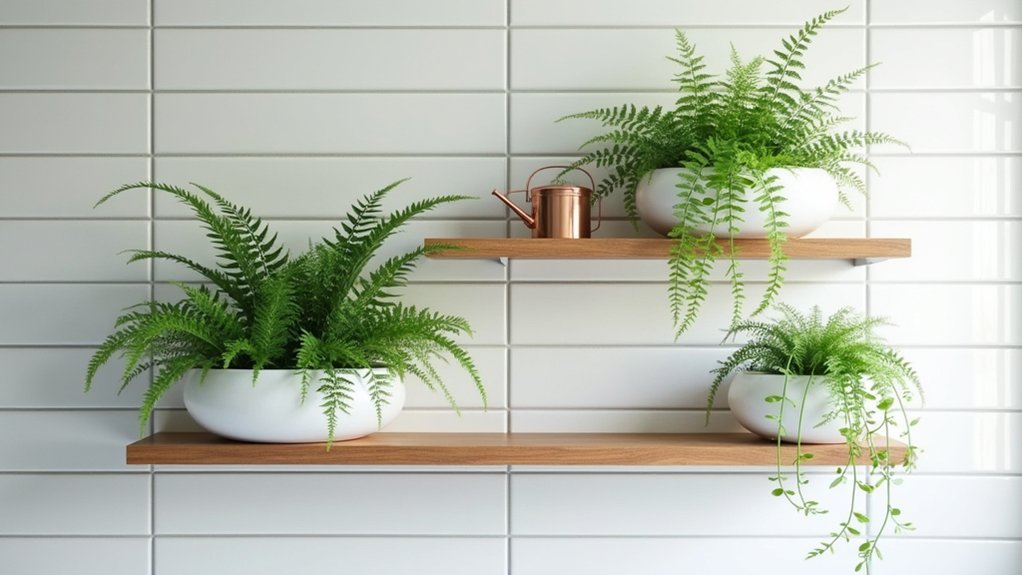
Floating shelves adorned with cascading ferns create a striking vertical garden effect in bathroom spaces, with delicate fronds spilling gracefully downward to soften harsh bathroom lines. Boston ferns, Button ferns, and Maidenhair ferns are particularly well-suited for this setup, as their natural trailing habits maximize the dramatic impact while making efficient use of limited bathroom space.
The combination of clean-lined floating shelves and organic plant forms adds both architectural interest and natural beauty to the bathroom environment.
Growing Conditions:
- Medium to bright indirect light, avoiding direct sunlight
- High humidity levels (60-80%)
- Consistent soil moisture with well-draining potting mix
- Temperature range of 65-75°F (18-24°C)
- Monthly feeding with balanced liquid fertilizer during growing season
- Use containers with drainage holes mounted on water-resistant shelves
Regular grooming is essential for maintaining attractive cascading ferns on floating shelves. Remove any yellowed or brown fronds at the base, rotate pots quarterly for even growth, and mist the plants several times per week if bathroom humidity drops.
Dust the fronds gently with a soft brush to maintain their lush appearance and ensure proper photosynthesis. When fronds become too long or start to look sparse, trim them back to encourage fuller growth and maintain the desired cascading effect.
Tropical Peace Lilies for Humidity Lovers
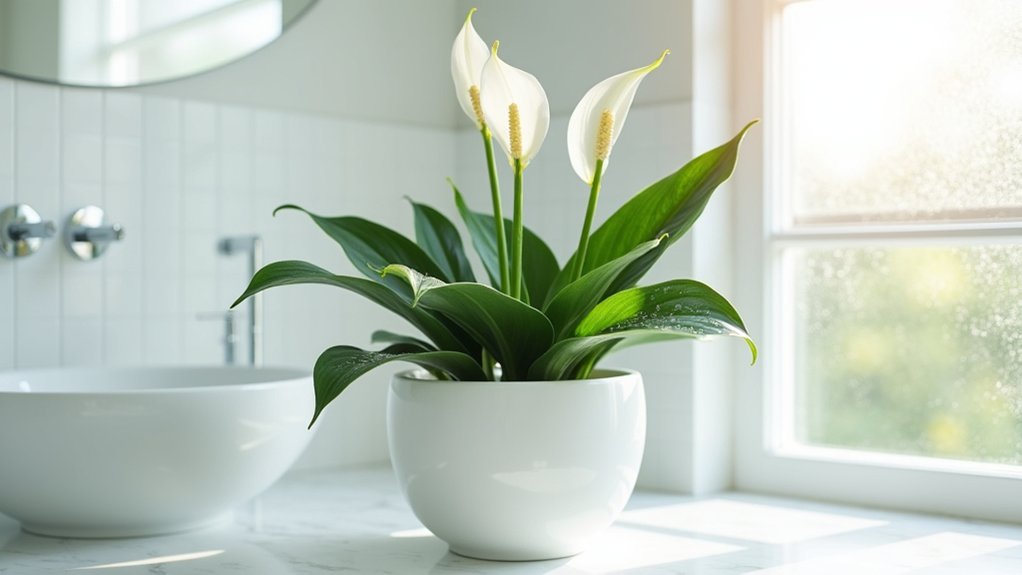
Peace lilies (Spathiphyllum) are elegant tropical plants that thrive in bathroom environments due to their love of humidity. These glossy-leaved beauties feature dark green foliage and distinctive white flowers that resemble calla lilies, rising above the leaves on tall stems. The plants’ compact growth habit and air-purifying qualities make them excellent choices for bathroom spaces of any size.
- Light: Bright indirect light; can tolerate low light conditions but may not flower
- Water: Keep soil consistently moist but not waterlogged; water when top inch of soil feels dry
- Humidity: Minimum 50%; thrives in higher humidity levels
- Temperature: 65-80°F (18-27°C)
- Soil: Well-draining potting mix rich in organic matter
- Pot: Container with drainage holes
- Fertilizer: Monthly feeding with balanced liquid fertilizer during growing season
Regular grooming keeps peace lilies looking their best in bathroom settings. Remove yellowing leaves at the base and trim spent flowers close to the soil line.
Dust the leaves periodically with a damp cloth to maintain their glossy appearance and ensure optimal photosynthesis. Watch for signs of overwatering, such as leaf yellowing or root rot, and adjust care accordingly.
Repot every 2-3 years when the plant becomes rootbound, choosing a container one size larger than the current pot.
Wall-Mounted Vertical Garden Solutions
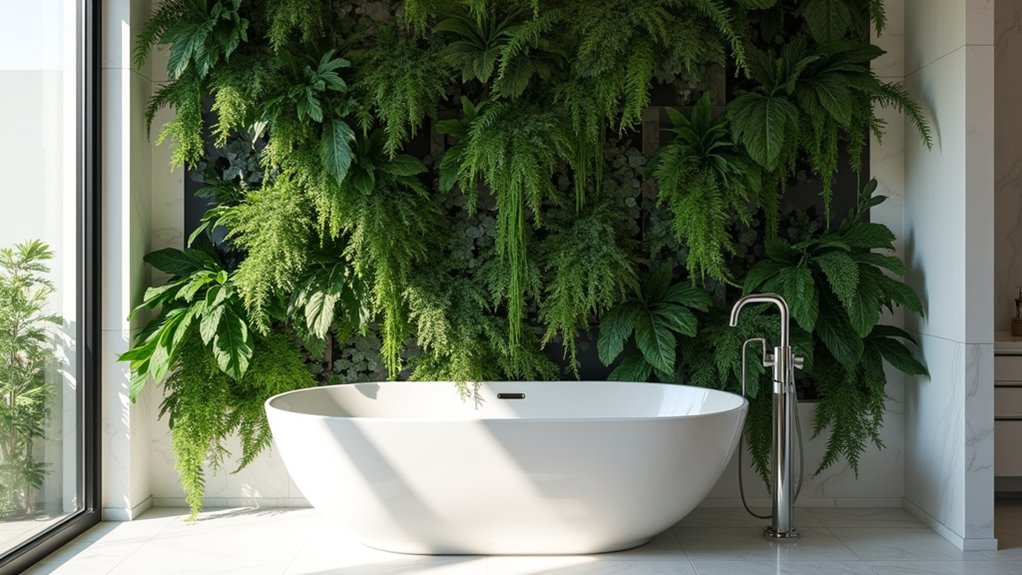
Wall-mounted vertical gardens transform bathroom walls into living tapestries of greenery, creating a striking focal point while maximizing limited space. These modern garden systems typically consist of modular panels, pocket planters, or specialized frames mounted directly to the wall, allowing plants to grow upward rather than outward.
The arrangement can range from simple rows of individual planters to complex, interwoven designs that create a seamless wall of vegetation.
- Light Requirements: Moderate to bright indirect light; avoid direct sunlight which can damage plants
- Water Needs: Regular watering schedule with good drainage to prevent water damage to walls
- Humidity: Thrives in naturally humid bathroom environment
- Soil Type: Well-draining potting mix specifically formulated for vertical gardens
- Temperature: Consistent warmth between 65-80°F (18-27°C)
- Mounting: Secure attachment to wall with proper waterproofing barriers
- Plant Selection: Mix of trailing and compact plants suitable for indoor bathroom conditions
Regular maintenance is crucial for wall-mounted vertical gardens‘ longevity and appearance. Inspect the mounting system monthly for signs of water damage or loose fixtures, and trim plants to maintain desired shape and prevent overgrowth.
Remove yellowed or dead foliage promptly to prevent moisture-related issues, and rotate plants if certain areas show signs of uneven growth.
Consider installing a drip irrigation system or self-watering setup to ensure consistent moisture levels while minimizing the risk of water damage to walls.
